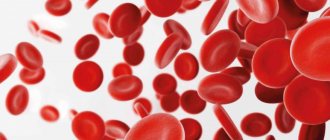Erythremia is a tumor clonal disease of the hematopoietic system, in which there is proliferation of erythroid, granulocytic and megakaryocytic lineages of hematopoiesis with predominant activation of erythropoiesis. At the same time, an increase in the level of red blood cells and hemoglobin, thrombocytosis and leukocytosis is noted in the blood. Almost all patients with erythremia are carriers of the JAK2V617F mutation.
- How does erythremia develop?
- Symptoms of erythremia
- Stages of erythremia
- Diagnosis of erythremia
- Treatment of erythremia
- Prognosis for erythremia
How does erythremia develop?
The causes of erythremia are still unknown. It is believed that this is a multi-stage disease in which, under the influence of external factors, the genome of a normal cell is damaged, which leads to its malignant transformation and the formation of a tumor cell clone that replaces normal hematopoiesis.
Almost all patients have a mutation in the JAK2 gene. Exon 14 is usually affected; 90-96% of patients have the V617F mutation. 2% of patients have mutations in exon 12. Damage to other genes, in particular MPL, CALR, is very rarely detected. All of these genetic pathologies are specific to erythremia, so their determination is necessary to confirm the diagnosis.
So, molecular genetic disorders cause activation of the JAK-STAT signaling pathway, which leads to increased proliferation of hematopoietic sprouts and an increase in the number of blood cells.
Monocytes and megakaryocytes (platelet precursors) produce a variety of cytokines - biologically active molecules that stimulate fibrotic changes, the formation of new blood vessels, which ultimately leads to osteosclerosis and bone marrow fibrosis. In addition, massive production of cytokines contributes to the development of tumor intoxication, which aggravates the general condition of patients.
There is also a disruption in the connection of stem cells with the microenvironment. This provokes the formation of foci of hematopoiesis outside the bone marrow. The liver and spleen are primarily affected.
Symptoms of erythremia
Clinically, erythremia manifests itself in two syndromes:
- Plethora (plethora). This syndrome is characterized by an increase in the number of circulating red blood cells. Symptomatically manifested by headaches, dizziness, attacks of rapid heartbeat, itchy skin and visual disturbances. The skin and mucous membranes have a bluish tint. Vascular complications are also possible: thrombosis, erythromelalgia (redness of the fingers, pain and burning sensation in them).
- Myeloproliferative syndrome - develops as a result of hyperplasia of hematopoietic germs. Symptomatically manifested by weakness, fever, sweating, itchy skin, bone pain. With the breakdown of granulocytes, a disturbance in urate metabolism is observed, which leads to the development of gout, kidney stones and urate diathesis.
Stages of erythremia
During its development, erythremia goes through several stages. The first, also known as initial, can last more than 5 years. During this period, moderate manifestations of plethoral syndrome are mainly present. The blood test shows moderate erythrocytosis, and in the bone marrow there is an increase in the proliferation of all hematopoietic lineages with the exception of the lymphocytic lineage. The spleen is not enlarged, complications rarely develop.
The second stage of erythremia is polycythemia. It is divided into 2 substages A and B. Stage A lasts 5-15 years. It is characterized by an increase in the number of formed elements in the blood. As a result, a pronounced plethoric syndrome is formed, which is complicated by thrombosis, bleeding, and an increase in the size of the liver and spleen. In the blood test, cytosis increases; in the bone marrow, in addition to the proliferation of erythropoietic, granulocytic and thrombopoietic lineages, cicatricial changes are noted.
With erythremia in stage B, cytosis and clinical symptoms continue to increase. Foci of tumor growth form in the spleen, and cicatricial changes progress in the bone marrow.
Stage 3 of erythremia - anemic. Here, bone marrow fibrosis already develops, which leads to its depletion and a decrease in the level of blood cells. The disease can transform into acute leukemia.
Course and outcomes
The course of erythremia is chronic, steadily progressing. The average duration of an untreated disease is from 8 to 10 years.
There are three phases of the disease:
• initial (prodromal);
• erythremic (polycythemic);
• terminal (outcome phase).
The initial phase is characterized by slight erythrocytosis (5-6 million) and the absence of pronounced leukocytosis and thrombocytosis. The disease in this phase is almost asymptomatic.
The erythremic phase eventually passes into the third - terminal phase of the disease, which in turn is heterogeneous.
It is necessary to distinguish:
• Outcomes associated with organ and vascular pathology in erythremia: liver cirrhosis, coronary thrombosis, softening areas in the brain due to thrombosis and hemorrhage, etc.
• “Hematological” outcomes due to the very essence of erythremia, which is a disease of the hematopoietic system. Of these, the main outcomes are anemia and myeloid leukemia.
The transformation of erythremia into anemia is based on the gradual development of myelofibrosis and osteomyelosclerosis. The development of severe myelofibrosis syndrome is preceded by the stage of myeloid metaplasia of the spleen. The latter occurs in the erythremic phase, when the bone marrow is still sharply hyperplastic.
The development of myelofibrosis with erythremia is accompanied by a gradual enlargement of the spleen and liver due to myeloid metaplasia. Myeloid metaplasia of the spleen and liver is an expression of the myeloproliferative, systemic nature of the disease. At the same time, extramedullary foci of hematopoiesis that arise against the background of progressive myelofibrosis have a known compensatory value. With the development of myelofibrosis, external signs of erythremia gradually disappear. Red blood counts return to normal and remain at this level sometimes for several years; then anemia develops. The number of leukocytes ranges from leukopenic to subleukemic numbers. The content of band and segmented neutrophils is always sharply increased, there is a moderate shift to myelocytes, less often - myeloblasts. Normoblastosis, polychromasia, and basophilic punctation of erythrocytes appear.
The diagnosis of myelofibrosis is established on the basis of a bone marrow biopsy and puncture of the spleen and liver.
Another line of development of erythremia is the outcome of acute and chronic myeloid leukemia.
Acute myeloid leukemia is the cause of death in patients with erythremia in 10-20% of cases.
Diagnosis of erythremia
As part of the diagnosis of erythremia, the patient undergoes a comprehensive examination, which includes the following measures:
- Anamnesis and physical examination, during which the color of the skin of the face and extremities is assessed. The size of the liver and spleen must be determined.
- A detailed blood test, including counting the number of blood cells and erythrocyte indices.
- Trephine biopsy of the bone marrow followed by histological and histochemical examination.
- Determination of erythropoietin level.
- Molecular genetic testing for the presence of specific V617F mutations.
- Ultrasound of the liver and spleen to accurately determine their size.
The diagnosis of erythremia is made according to the 2021 WHO criteria, which distinguishes three major criteria and one minor one.
Major criteria for erythremia:
- The hemoglobin level is more than 160 g/l in women and more than 165 g/l in men.
- Hyperplasia of three myelopoiesis lineages in bone marrow trephine.
- The presence of a mutation in the JAK2 gene.
A minor criterion is a decrease in erythropoietin levels.
To make a diagnosis of erythremia, it is necessary either to have all three major criteria, or 1-2 major and one minor.
Diagnosis and differential diagnosis
Currently, due to the advent of effective treatments for erythremia, the importance of the differential diagnosis of erythremia has increased significantly. It is necessary to clearly differentiate erythremia from a large group of erythrocytoses, which have nothing in common with erythremia except external similarity in the form of an increase in the number of red blood cells.
Erythremia is supported by a high degree of erythrocytosis, leukocytosis, and in the absence of the latter, noticeable and persistent neutrophilia and a band shift in the blood count, as well as thrombocytosis. Hypoxic erythrocytosis is characterized by an increase in the volume of red blood cells.
Splenomegaly is characteristic of erythremia and is usually absent in erythrocytosis.
A hematocrit value above 70/30 is more typical for erythremia. With erythrocytosis, a moderate increase in hematocrit may occur.
Determining the mass of erythrocytes helps to differentiate erythremia from relative erythrocytosis, as well as from absolute (secondary) erythrocytosis, in which the mass of erythrocytes, although increased, is to a much lesser extent than with erythremia.
A decrease in the oxygen content in arterial blood is characteristic of hypoxic erythrocytosis and does not occur with erythremia. A very significant differential diagnostic feature is bone marrow megakaryocytosis in erythremia.
Most likely, an early and differential diagnosis of erythremia is established on the basis of a histological examination of bone marrow obtained by trepanobiopsy. Erythremia is characterized by pronounced hyperplasia of the cellular elements of the bone marrow, leading to almost complete displacement of fat, and especially megakaryocytosis. In secondary erythrocytosis, megakaryocytosis is usually absent, hyperplasia of cellular elements is absent or very small. The simplicity and safety of this research method allow us to recommend it for the differential diagnosis of erythremia in all unclear cases.
Treatment of erythremia
The main goals of treatment for erythremia are:
- Preventing the formation of blood clots and treating already developed thrombosis and thromboembolism.
- Reducing the level of tumor intoxication and controlling associated symptoms (fever, itching, weight loss).
- Reducing the risk of transformation into acute myeloid leukemia or myelofibrosis.
- Preventing the development of complications if surgical interventions or pregnancy are necessary.
To assess the likelihood of developing thrombosis during erythremia, risk stratification is carried out according to the following criteria:
- Age over 60 years.
- Presence of thrombosis in the past.
- Cardiovascular risk factors: arterial hypertension, excess weight, diabetes, physical inactivity.
If the patient does not have the listed factors, then he is classified as a low-risk group, in the presence of cardiovascular factors - as an intermediate one, and if he is over 60 years old and/or has a history of thrombosis, he is considered to be at high risk of thromboembolic complications. The platelet level does not affect the risk of thrombosis, but it plays a certain role in the development of bleeding. To prevent the development of thrombosis, it is necessary to eliminate cardiovascular risk factors, as well as prescribe antiplatelet agents.
In addition, the following methods are used to treat erythremia:
- Removing excess red blood cells in the blood. It can be carried out either using hemoexcursion (regular bloodletting) or erythrocytepheresis (removal of red blood cells directly).
- Cytoreductive therapy. Cytostatics and interferons are used.
- Treatment of complications of already developed thrombosis.
Hemoexcursions (bloodletting) for erythremia
Bloodletting is used to reduce the volume of circulating blood. The volume of hemoexcursion is 250-500 ml per procedure, after which the missing volume of fluid is replenished with saline solution. Or the second option is a preliminary infusion of antiplatelet agents together with saline in a volume exceeding the volume of blood removed. Sessions are carried out every other day until the hematocrit reaches 40-45%. For elderly patients, sessions are performed 2 times a week, or the volume of blood excursion is reduced.
Erythrocytopheresis
Erythrocytapheresis refers to methods of extracorporeal detoxification, which replaced bloodletting. It is based on the removal of red blood cells, followed by the return of plasma and replenishment of the volume with solutions of crystalloids or colloids. In one session, up to 400 ml of red blood cells can be removed.
Acetylsalicylic acid preparations
Acetylsalicylic acid, or aspirin, is prescribed to prevent thrombotic complications. Aspirin should be prescribed to every patient with erythremia unless there are contraindications. If they are present, clopidogel or ticlopidine is prescribed.
Cytoreductive therapy
Hydroxyurea
Theoretically, hydroskiurea can be used as part of first-line therapy in patients of any age. But due to the fact that it is genotoxic and can provoke a leukemic effect, such first-line treatment is not recommended for patients under 50 years of age and pregnant women. It is also necessary to discontinue treatment in case of intolerance and ineffectiveness of therapy. The criterion for intolerance to hydroxyurea is the presence of at least one of these symptoms:
- Exceeding the hematocrit by more than 45% 3 months after treatment with hydroxyurea at a dosage of 2000 mg/day.
- Lack of control of myeloproliferation. This may be indicated by a platelet level of more than 400×10 9 and a leukocyte level of more than 10×10 9 after 3 months of treatment.
- Presence of an enlarged spleen (more than 10 cm below the costal margin) or the inability to eliminate the symptoms of splenomegaly.
- Myelopenia when using minimal dosages of drugs - platelet level below 100×10*9 or hemoglobin below 100 mg/l.
- Ulcers on the legs.
- Damage to the skin and mucous membranes.
- Disruption of the gastrointestinal tract.
- Pneumonitis.
- Fever.
Interferon alpha
Interferon alfa is highly effective against erythremia and allows a molecular response to be achieved in some patients. It also relieves plethoral syndrome well, reducing the severity of itching. However, its widespread use is limited by poor tolerability. It is mainly recommended for patients under 50 years of age.
Busulfan
With the help of busulfan, active control of erythremia is possible, however, with long-term use, the risk of developing secondary leukemia increases. Therefore, it is used in patients over 70 years of age with intolerance to hydroxyurea and interferons.
Symptoms and clinical picture
Symptoms and complications of erythremia are caused by:
• increase in blood mass (true plethora);
• increased blood viscosity and slowed blood flow;
• an increase in the number of blood platelets and leukocytes.
The most common subjective complaints of patients are heaviness in the head, pain of varying intensity, rush of blood to the head, tinnitus, feeling of heat, angina-like pain in the heart, discomfort and pain in the epigastric region.
Also characteristic of erythremia: skin itching, worsening after a bath, pain in the bones and especially in the lower extremities, sometimes blurred vision and double vision, hearing impairment. The subjective state of most patients is impaired, but in isolated cases, despite high blood counts, patients feel practically healthy.
The most striking external sign of the disease is the characteristic hyperemic coloration of the skin and visible mucous membranes, due to true plethora. The patient's face gives the impression of being inflamed, its color is brick-red or cherry-red. In contrast to cyanosis, this similar complexion is called “erythrosis.” However, the tip of the nose, ears, and limbs have a purple-cyanotic tint (acrocyanosis). The skin of the body is intensely pink. The patient's tongue and lips are either bright red, carmine, or crimson. The gums are loosened and often bleed. The conjunctivae are hyperemic. The skin capillaries in the venous part are sharply dilated and elongated, with aneurysmal dilatations; the blood flow in them is slowed down. Capillary ruptures with hemorrhages into the skin and mucous membranes are often observed.
Capillaroscopy of the nail bed reveals characteristic changes: the general background of the capillaries is intense red to purple, with a cyanotic tint. The capillaries are varicose, tortuous, form “figure-of-eight” loops, increased in number, the movement of blood and them is slowed down, stasis and sometimes extravasation are observed.
Typical external signs of erythremia are found in 90% of cases. There is a possibility of absence of external signs of erythremia: in persons with dark skin color, especially women, as well as in the very initial phase of the disease, erythrosis may be absent.
The second most common symptom of erythremia is splenomegaly. It is noted in 66% of cases.
In a number of patients, the spleen takes part in the myeloproliferative process, especially if there is a significant increase in its size and a long history of suffering. In the anemic phase of the disease, progressive enlargement of the spleen occurs, as a rule, due to myeloid metaplasia of the organ. An indirect indication of the presence of myeloid metaplasia is an increase in leukocytosis or other neutrophil shift to the left, the appearance of normoblastosis and polychromasia of erythrocytes.
An equally important sign of the disease is liver enlargement - the latter is observed on average in 62% of cases. Hepatomegaly of the liver can be caused by various factors, of which the main one is blood stagnation: the liver, like the spleen, is the main blood depot in the body. Increased blood supply to the liver entails protein degeneration of liver cells and proliferation of connective tissue under the influence of the harmful effects of red blood cell hemolysis products.
Liver cirrhosis is a rare complication of erythremia; a violation of the functional state of the liver is determined much more often.
In patients in the anemic phase of the disease, myeloid metaplasia is detected in the liver, as well as in the spleen.
Arterial hypertension is a less permanent symptom of the disease; it is more often found in patients without plexus and hepatomegaly. Blood pressure above 150/90 mmHg is observed in a third of patients.
It is necessary to distinguish symptomatic, “erythremic” hypertension, caused by plethora and disappearing as the blood mass normalizes, from hypertension itself. The latter is characterized by an increase in not only systolic, but also diastolic pressure, characteristic hypertrophy of the left ventricle of the heart, renal and other symptoms.
Patients get tired easily physically and mentally. For the most part, they are drowsy and apathetic: due to venous congestion in the brain, they constantly complain of a rush of blood to the head, an “unclean” head and a feeling of a “lead head”, a feeling of heat, headaches: there is tinnitus, decreased hearing and visual impairment up to complete amaurosis. Ophthalmoscopy reveals varicose veins, engorged with blood, and sometimes small hemorrhages.
Due to venous hyperemia of organs, congestion in the respiratory tract (bronchitis) and kidneys (albuminuria) often develops. Dyspeptic symptoms are often observed, sometimes bloody vomiting and intestinal bleeding occurring due to thrombosis, followed by rupture of dilated and blood-filled veins of the esophagus, stomach and intestines. Gastric secretion in Vaquez disease is inconsistent: along with increased secretion, some patients experience hypo- and achylia.
Gastric and duodenal ulcers are observed in 10-20% of patients with erythremia. The causes of ulceration of the gastric and duodenal mucosa during erythremia are considered to be a slowdown in blood flow and thrombosis of small vessels of the gastrointestinal tract.
Of particular interest is vascular pathology in erythremia. Plethoric plethora leads to the fact that erythremia occurs as a vascular disease with all the ensuing clinical consequences.
Slowing the speed of blood flow, increased blood viscosity and the richness of its formed elements contribute to the occurrence of arterial and venous blood clots. Thrombosis of cerebral vessels is especially dangerous. Thrombosis of the splenic and renal arteries is often observed. With portal vein thrombosis, patients develop acute portal stasis syndrome: severe abdominal pain, bloody vomiting, and intestinal bleeding; in case of profuse bleeding, patients may die, and if they survive, then after the bleeding stops they develop chronic portal stagnation syndrome with ascites; the latter may disappear due to the vascularization of the thrombus and the development of collateral circulation.
Recurrent thrombosis of the eyelids of the lower extremities can lead to the formation of trophic ulcers and erythroderma. The skin of the legs becomes dark purple in color, thickened, and hot to the touch. Patients suffer from severe pain in the lower extremities, due to which they become completely disabled.
The presence of a tendency to thrombosis and bleeding with the same suffering seems paradoxical at first glance. Bleeding in erythremia is based on the following reasons: overfilling of blood vessels, impaired retraction of a blood clot due to lack of serum and, possibly, qualitative inferiority of platelets, as well as insufficiency of plasma components of the blood coagulation system - prothrombin, fibrinogen.
Erythremia predisposes to vascular lesions of an organic (obliterating endarteritis) and functional (acroparesthesia and erythromelalgia) nature. Vascular damage underlies the visceral, organ pathology observed with erythremia. These include: coronary thrombosis with subsequent development of heart failure, cirrhosis of the liver, thrombosis of cerebral vessels, and occasionally pneumosclerosis. The range of vascular and visceral pathologies is quite diverse. Cases of erythremic psychosis and significant visual impairment associated with damage to the retinal vessels have been observed.
The examples given do not exhaust the variety of symptoms and complications of erythremia.
With erythremia, there is an absolute increase in the number of red blood cells, leading to an increase in the total mass of circulating blood, sometimes by 2-3 times (up to 10-12 liters or more). The mass of circulating blood increases due to physical activity. The erythrocyte-plasma ratio is increased, reaching 85/15 and 90/10 (normal is 45/55).
The degree of increase in red blood counts depends on the phase, severity of the disease, as well as previous therapy. Most often, the number of red blood cells is 6-8 million, in rare cases reaching 10-12 million, hemoglobin is 18-22 g/l, in rare cases reaching 25-28 g/l. The color index is usually below one, on average 0.7-0.8. Red blood cells are of normal size (average 7.5 microns). The reticulocyte count is usually normal. In patients who use frequent bloodletting, moderate reticulocytosis is noted. In rare cases, normoblastosis occurs. With the transition of erythremia to the phase of myeloid metaplasia, the content of normoblasts increases, polychromatophils and degenerative changes in erythrocytes appear: basophilic punctuation, anisocytosis, poikilocytosis, schizocytosis. Characteristics of erythremia are leukocytosis and thrombocytosis.
Leukocytosis is established in approximately half of the cases. Neutrophilia is observed in 80% of cases, in 60% of cases there is a pronounced band shift. “Leukomoid reaction” - leukocytosis and a shift in the neutrophil formula to young and myelocytes - is noted in 8% of cases, a leukemic blood picture corresponding to the picture of chronic myeloid leukemia - in 3% of cases. A characteristic symptom is eosinophilia, reaching 28% in some cases and observed in 20% of cases.
Thrombocytosis (an increase in the number of platelets over 400 thousand) is established in approximately 50% of cases. Sometimes giant plates are found in the blood.
The physical properties of blood correspond to the increased content of red blood cells per unit volume: the dry residue of the blood is greatly increased, the viscosity is sharply increased; ROE is slow (0-2 mm per hour); retraction of the blood clot is impaired (due to lack of serum).
The content of bilirubin in the blood is normal or slightly increased, averaging 1 mg/l (indirect reaction).
Histological examination of the bone marrow in erythremia (intravital - by trepanobiopsy and postmortem) convinces of the presence of pronounced hyperplasia of bone marrow cells.
Among the elements of leukopoiesis, mature forms of granulocytes predominate, the sum of which exceeds the totality of myelocytic-promyelocytic forms. In cases of erythremia with a “leukemoid” blood picture, a leukoblastic reaction is observed with the mobilization of promyelocytes and myeloblasts.
In case of erythremia, hyperplasia of the giant cell apparatus deserves special attention. Qualitatively, megakyrocytes are characterized by particularly large sizes, reaching 100 μm in diameter.
Prognosis for erythremia
In general, the prognosis for erythremia is relatively favorable. The overall 10-year survival rate is about 75%. But the disease can transform into acute myeloid leukemia (5% risk) or myelofibrosis (slightly less than 10% risk).
Symptoms of erythremia (headaches, bone pain, paresthesia) can worsen the quality of life of patients. The main cause of death in patients is thrombosis, bleeding and severe infections, the risk of which increases when the pathology transforms into acute myeloid leukemia or myelofibrosis.
Treatment of erythremia at the Euroonko clinic is carried out using modern treatment protocols. In difficult cases, the decision is made collegiately by a council of specialists. We attach great importance to monitoring the patient during the period of remission. This also makes it possible to achieve an increase in the effectiveness of the treatment.
Book a consultation 24 hours a day
+7+7+78









